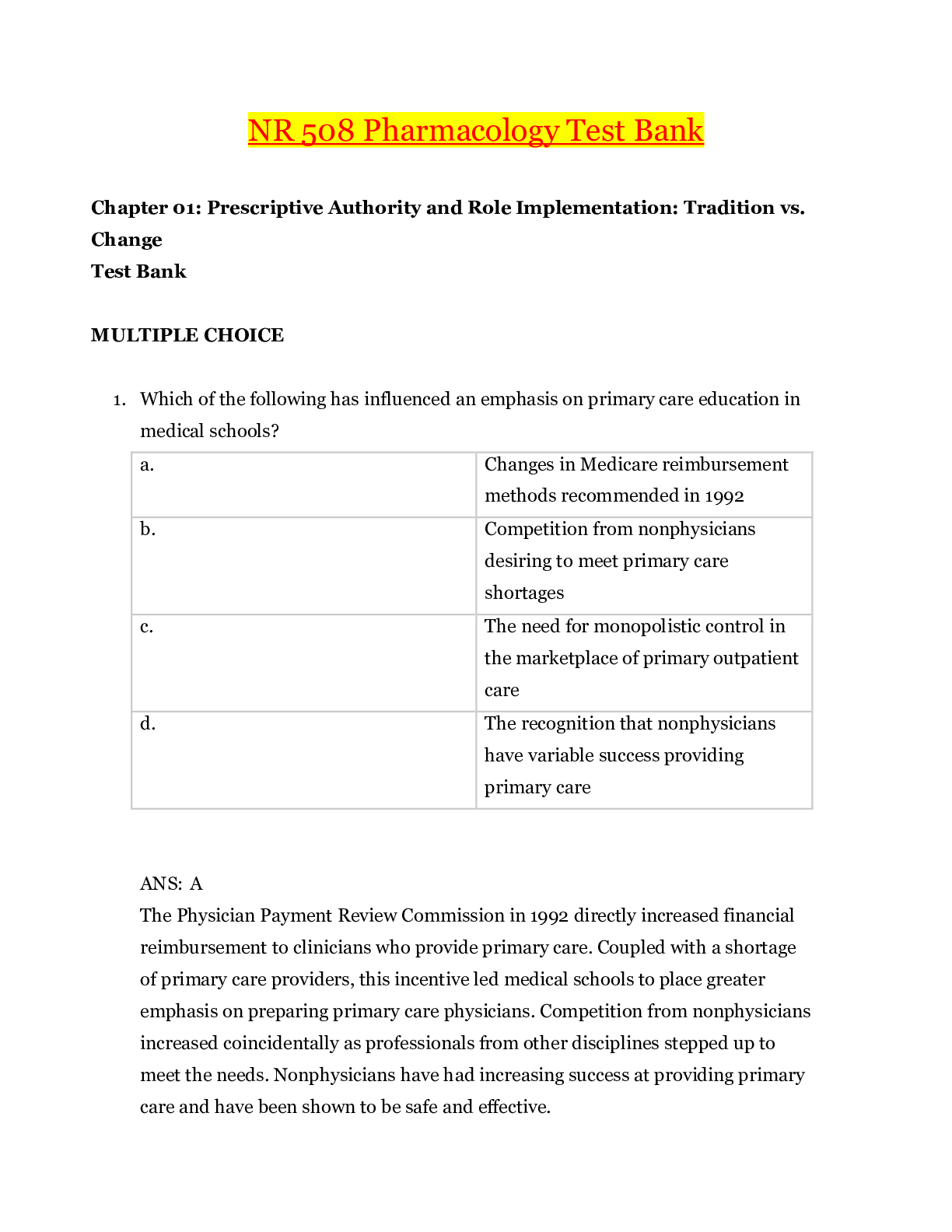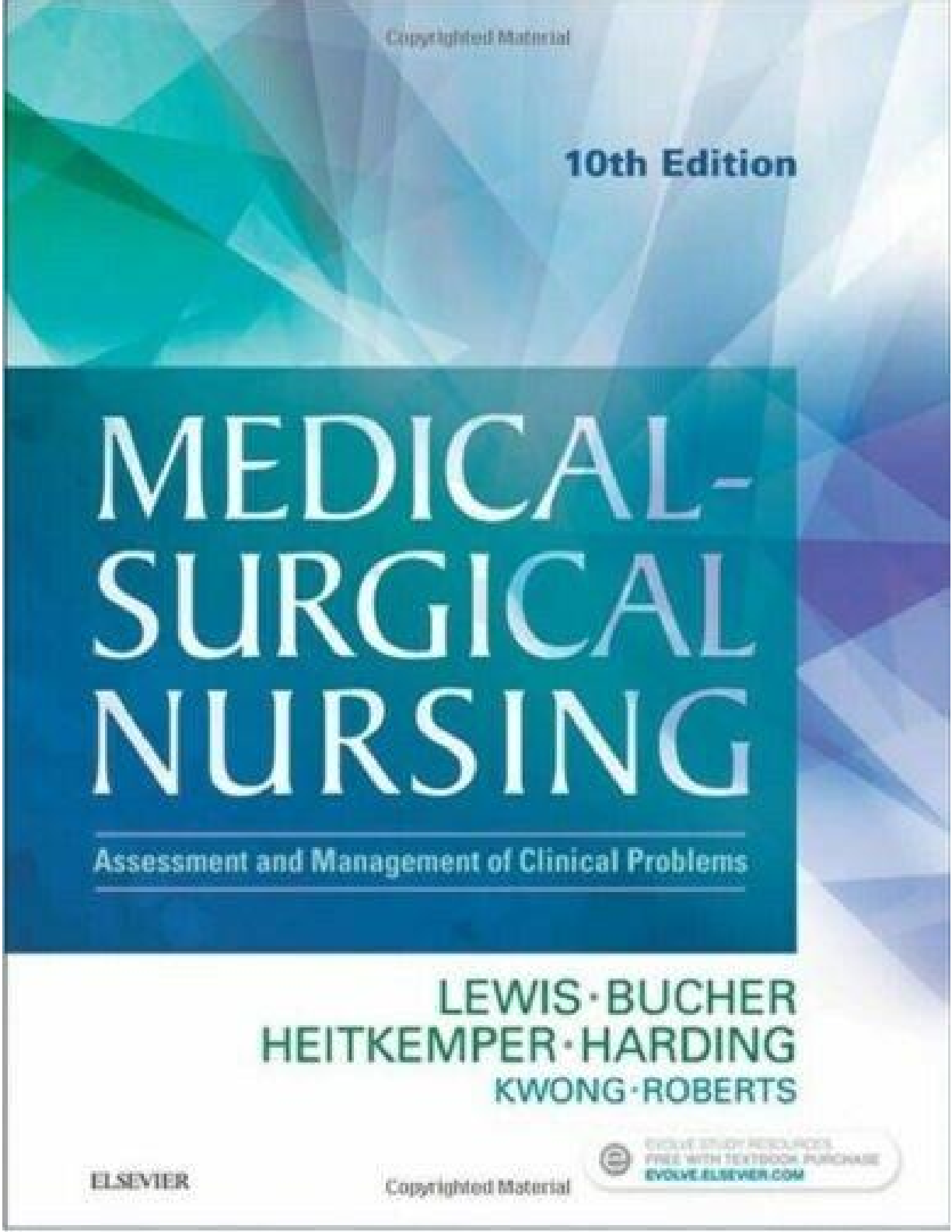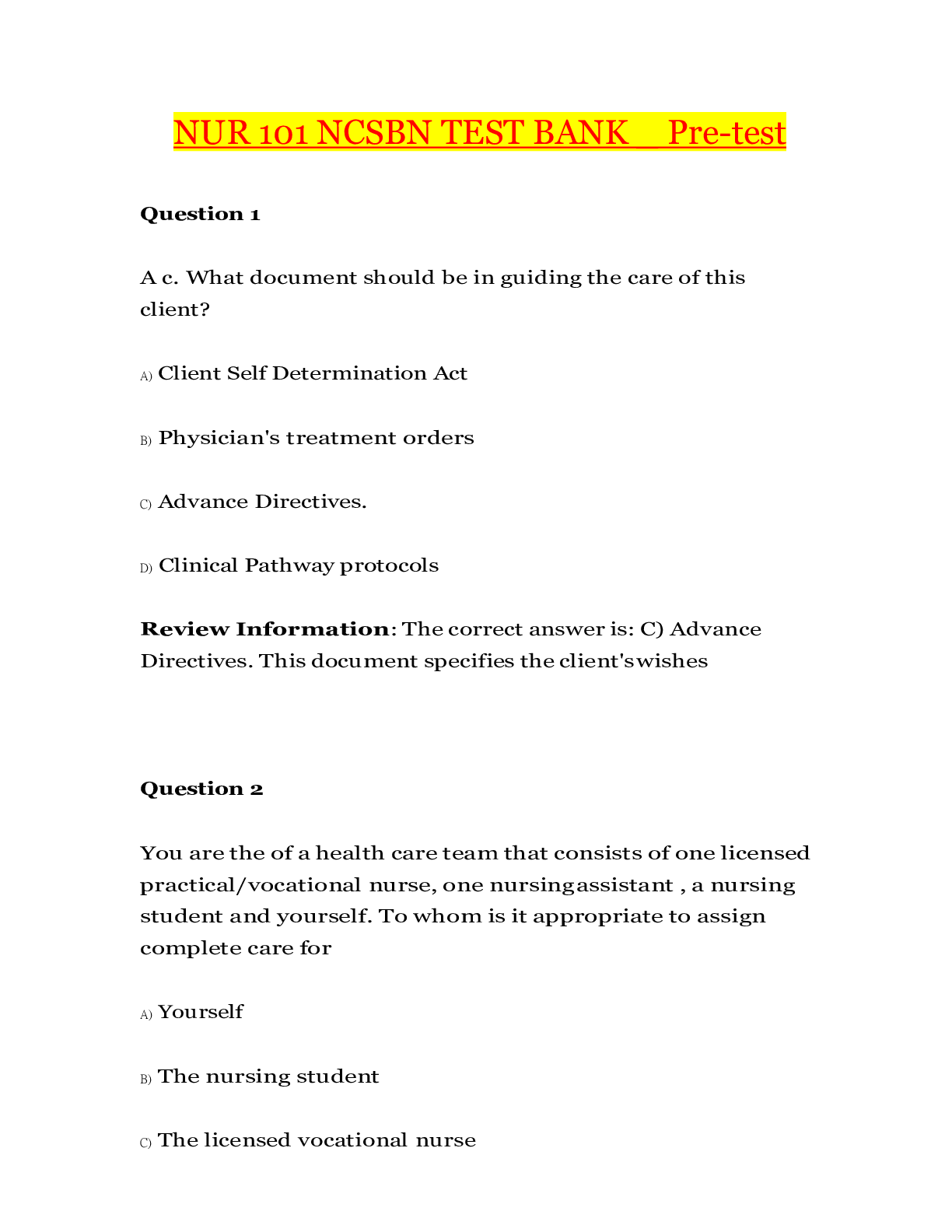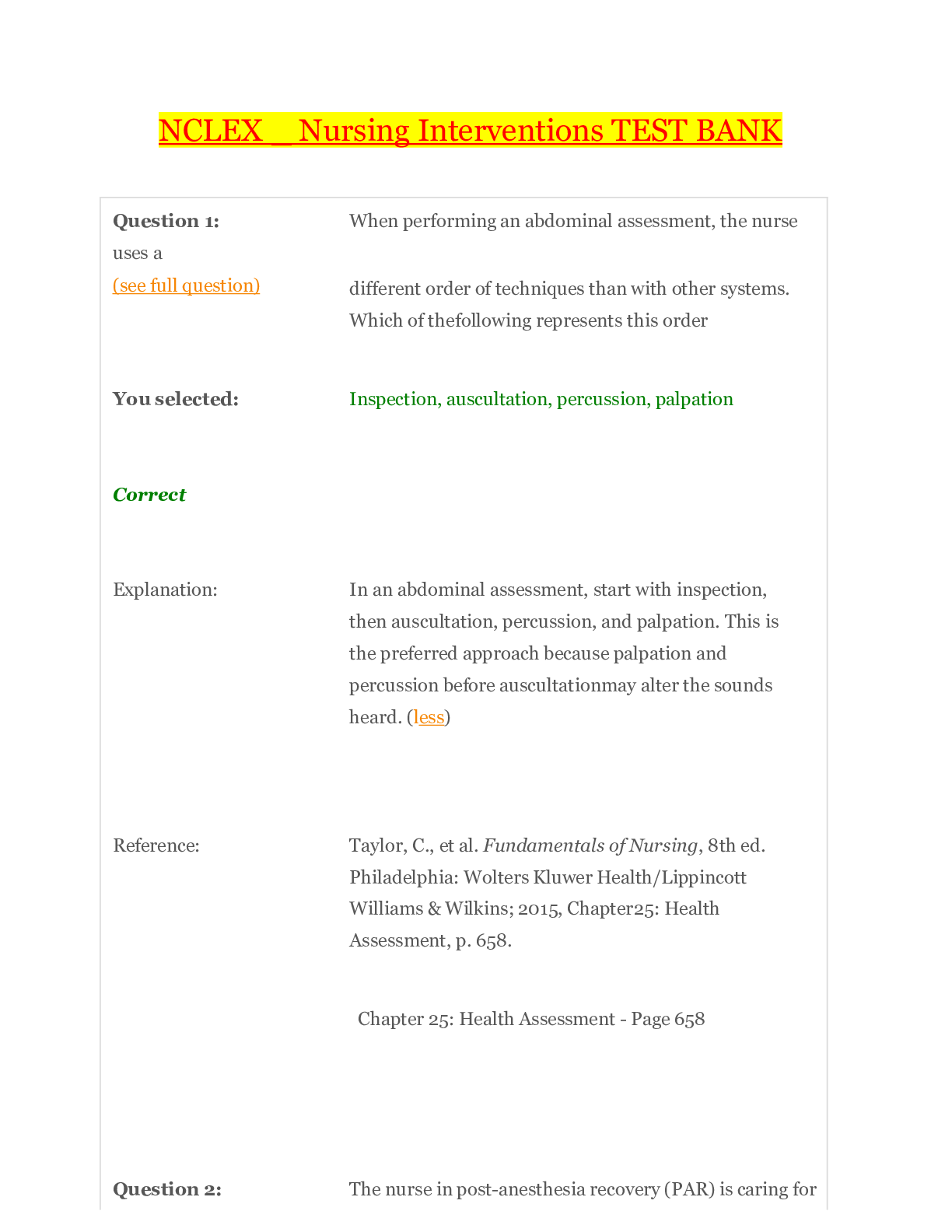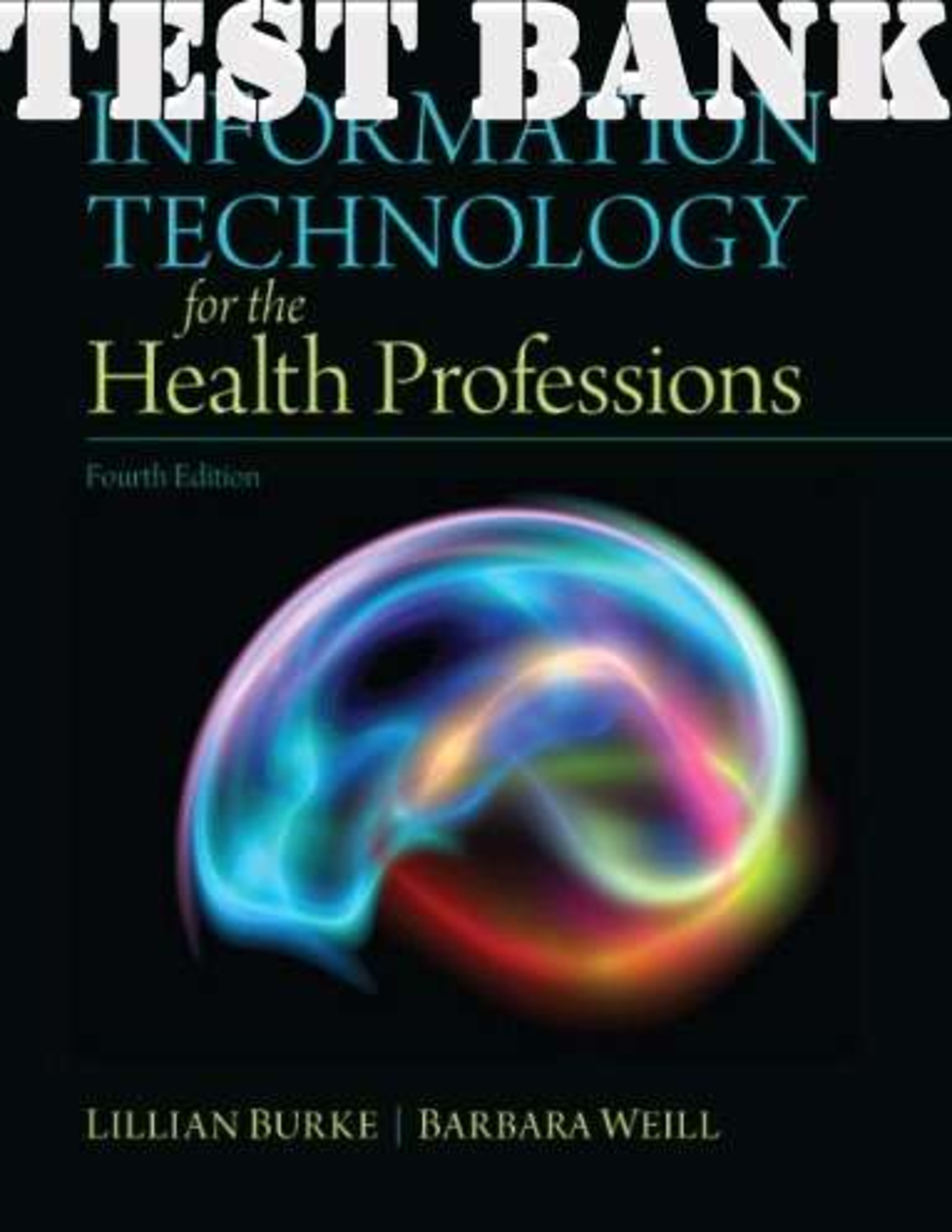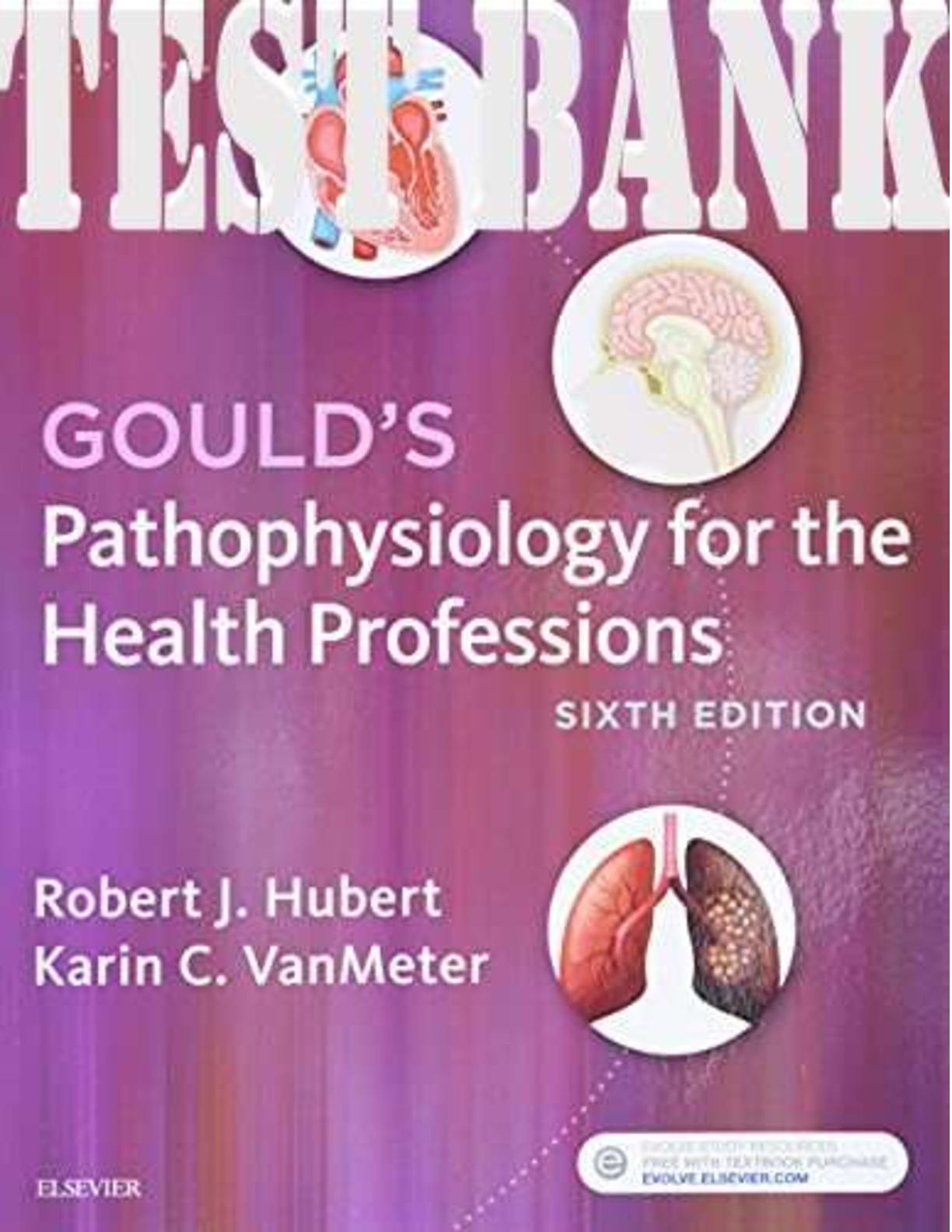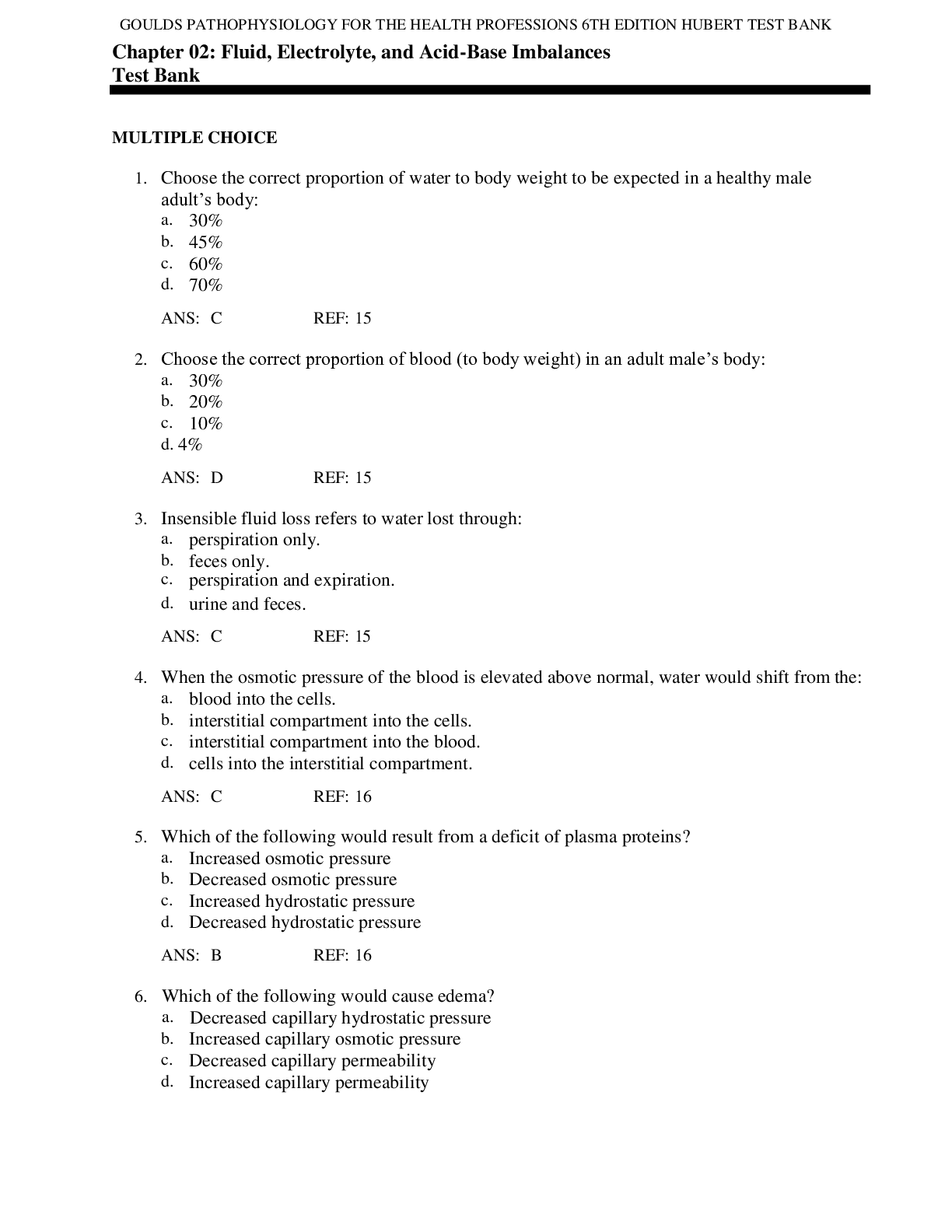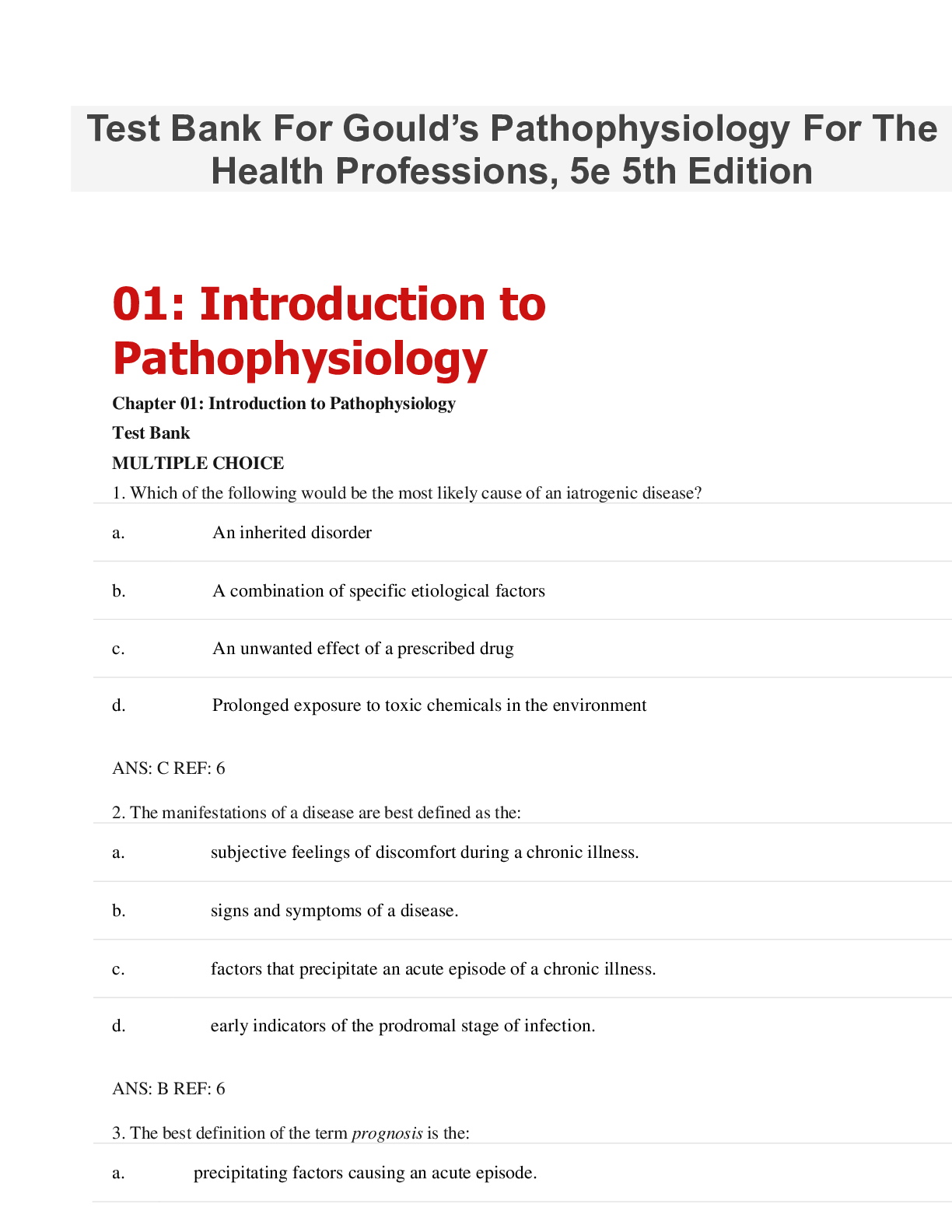*NURSING > TEST BANK > Burton's Microbiology for the Health Sciences 8th Edition | Microbiology for the Health Sciences (All)
Burton's Microbiology for the Health Sciences 8th Edition | Microbiology for the Health Sciences
Document Content and Description Below
1 http://ecx.images-amazon.com/images/I/51VRNWXMKJL._SS500_.jpg 10/5/20091 Microbiology: The Science Learning Objectives AFTER STUDYING THIS CHAPTER, YOU SHOULD BE ABLE TO: Define microbiolog... y, pathogen, nonpathogen, and opportunistic pathogen List several reasons why microorganisms are important (e.g., as a source of antibiotics) Explain the relationship between microorganisms and infectious diseases Differentiate between infectious diseases and microbial intoxications Outline some of the contributions of Leeuwenhoek, Pasteur, and Koch to microbiology Differentiate between biogenesis and abiogenesis Explain the germ theory of disease Outline Koch's postulates and cite some circumstances in which they may not apply Discuss two medically related fields of microbiology Introduction Welcome to the fascinating world of microbiology, where you will learn about creatures so small that they cannot be seen w ith the naked eye. In this chapter, you will discover the effects that these organisms have on our daily lives and the environment around us, and why knowledge of them is of great importance to healthcare professionals. You will learn that some of these tiny creatures are our friends, whereas others are our enem ies. You are about to embark on an exciting journey. En joy the adventure! What Is Microbiology? A microbiology course is an advanced biology course. Ideally, students taking microbiology should have some background in biology. As you know, biology is the study of living organisms (from bios, referring to living organisms, and logy, meaning “the study of”). Micro means very small—anything so small that it must be viewed with a microscope (an optical instrument used to observe very small objects). Therefore, microbiology is the study of very small living organisms—organisms called microorganisms or microbes. Microorganisms are said to be ubiquitous, meaning they are virtually everywhere. The various categories of microorganisms include viruses, bacteria, archaeans, some algae, protozoa, and some fungi (Fig. 1-1). These categories of microorganisms are discussed in detail in Chapters 4 and 5. Because most scientists do not consider viruses to be living organisms, they are often referred to as “infectious agents” or “infectious particles,” rather than microorganisms. Your first introduction to microorganisms may have been when your mother warned you about “germs” (Fig. 1-2). Although not a scientific term, “germs” are the microorganisms that cause disease. Your mother worried that you might become infected with these types of microorganisms. Diseasecausing microorganisms are technically known as pathogens (Table 1-1). Actually, only about 3% of known microbes are capable of causing disease (i.e., only about 3% are pathogenic). Thus, the vast majority of known microorganisms are nonpathogens—microorganisms that do not cause disease. P.2 Page 1 of 20 http://thepointeedition.lww.com/pt/re/9780781771955/bookContentPane_frame.htm;jsessi... 10/5/2009Some of the nonpathogens are beneficial to us and some have no effect on us at all. In newspapers and on television, we read and hear more about pathogens than we do about nonpathogens, but in this book you will learn about both categories—the microorganisms that help us (“microbial allies”) and those that harm us (“microbial enemies”). Why Study Microbiology? Although they are very small, microorganisms play significant roles in our lives. Listed below are a few of the many reasons to take a microbiology course and to learn about microorganisms: Figure 1-1. Family tree of microorganisms. Cellular microorganisms are divided into eucaryotes (organisms having a true nucleus, such as algae, fungi, and protozoa) and procaryotes (organisms lacking a true nucleus, such as archaeans and bacteria). Viruses are not considered to be cells (they are said to be acellular) and are, therefore, not included on this family tree. (The various categories of microorganisms are described in Chapters 4 and 5.) Page 2 of 20 http://thepointeedition.lww.com/pt/re/9780781771955/bookContentPane_frame.htm;jsessi... 10/5/2009 We have, living on and in our bodies (e.g., on our skin and in our mouths and intestinal tract), approximately 10 times as many microorganisms as the total number of cells (i.e., epithelial cells, nerve cells, muscle cells, etc.) that make up our bodies (10 trillion cells × 10 = 100 trillion microbes). It has been estimated that perhaps as many as 500 to 1,000 different species of microorganisms live on and in us. Collectively, these microbes are known as our indigenous microflora (or indigenous microbiota) and, for the most part, they are beneficial to us. For example, the indigenous microflora inhibit the growth of pathogens in those areas of the body where they live by occupying space, depleting the food supply, and secreting materials (waste products, toxins, antibiotics, etc.) that may prevent or reduce the growth of pathogens. Indigenous microflora are discussed more fully in Chapter 10. P.3 Figure 1-2. Germs. In all likelihood, your mother was your first microbiology Page 3 of 20 http://thepointeedition.lww.com/pt/re/9780781771955/bookContentPane_frame.htm;jsessi... 10/5/2009 Some of the organisms that colonize (inhabit) our bodies are known as opportunistic pathogens (or opportunists). Although such organisms do not usually cause us any problems, they have the potential to cause infections if they gain access to a part of our anatomy where they do not belong. For example, a bacterium called Escherichia coli (E. coli) lives in our intestinal tracts. This organism does not cause us any harm as long as it stays in our intestinal tract, but can cause disease if it gains access to our urinary bladder, bloodstream, or a wound. Other opportunistic pathogens strike when a person becomes run down, stressed out, or debilitated (weakened) as a result of some disease or condition. Opportunistic pathogens can be thought of as microorganisms awaiting the opportunity to cause disease. Microorganisms are essential for life on this planet as we know it. For example, some microbes produce oxygen by the process known as photosynthesis (discussed in Chapter 7). Actually, microorganisms contribute more oxygen to our atmosphere than do plants. Thus, organisms that require oxygen—humans, for example—owe a debt of gratitude to the algae and cyanobacteria (a group of photosynthetic bacteria) that produce oxygen. instructor. Not only did she alert you to the fact that there were “invisible” critters in the world that could harm you, she also taught you the fundamentals of hygiene— like handwashing. P.4 TABLE 1-1 Pathogens CATEGORY EXAMPLES OF DISEASES THEY CAUSE Algae A very rare cause of infections; intoxications (which result from ingestion of toxins) Bacteria Anthrax, botulism, cholera, diarrhea, diphtheria, ear and eye infections, food poisoning, gas gangrene, gonorrhea, hemolytic uremic syndrome (HUS), intoxications, Legionnaires' disease, leprosy, Lyme disease, meningitis, plague, pneumonia, Rocky Mountain spotted fever, scarlet fever, staph infections, strep throat, syphilis, tetanus, tuberculosis, tularemia, typhoid fever, typhus, urethritis, urinary tract infections, whooping cough Fungi Allergies, cryptococcosis, histoplasmosis, intoxications, meningitis, pneumonia, thrush, tinea (ringworm) infections, yeast vaginitis Protozoa African sleeping sickness, amebic dysentery, babesiosis, Chagas' disease, cryptosporidiosis, diarrhea, giardiasis, malaria, meningoencephalitis, pneumonia, toxoplasmosis, trichomoniasis Viruses Acquired immunodeficiency syndrome (AIDS), “bird flu,” certain types of cancer, chickenpox, cold sores (fever blisters), common cold, dengue, diarrhea, encephalitis, genital herpes infections, German measles, hantavirus pulmonary syndrome (HPS), hemorrhagic fevers, hepatitis, infectious mononucleosis, influenza, measles, meningitis, mumps, pneumonia, polio, rabies, severe Page 4 of 20 http://thepointeedition.lww.com/pt/re/9780781771955/bookContentPane_frame.htm;jsessi... 10/5/2009 Many microorganisms are involved in the decomposition of dead organisms and the waste products of living organisms. Collectively, they are referred to as decomposers or saprophytes. By definition, a saprophyte is an organism that lives on dead or decaying organic matter. Imagine living in a world with no decomposers. Not a pleasant thought! Saprophytes aid in fertilization by returning inorganic nutrients to the soil. They break down dead and dying organic materials (plants and animals) into nitrates, phosphates, and other chemicals necessary for the growth of plants (Fig. 1-3). Some microorganisms are capable of decomposing industrial wastes (oil spills, for example). Thus, we can use microorganisms—genetically engineered microbes, in some cases—to clean up after ourselves. The use of microorganisms in this manner is called bioremediation, a topic discussed in more detail in Chapter 10. Genetic engineering is discussed briefly in this section and more fully in Chapter 7. Many microorganisms are involved in elemental cycles (e.g., carbon, nitrogen, oxygen, sulfur, and phosphorous cycles). In the nitrogen cycle, certain bacteria convert nitrogen gas in the air to ammonia in the soil. Other soil bacteria then convert the ammonia to nitrites and nitrates. Still other bacteria convert the nitrogen in nitrates to nitrogen gas, thus completing the cycle (Fig. 1- 4). Knowledge of these microbes is important to farmers who practice crop rotation to replenish nutrients in their fields and to gardeners who keep compost pits as a source of natural fertilizer. In both cases, dead organic material is broken down into inorganic nutrients (e.g., nitrates and phosphates) by microorganisms. The study of the relationships between microbes and the environment is called microbial ecology. Microbial ecology, the nitrogen cycle, and other elemental cycles are discussed more fully in Chapter 10. Algae and bacteria serve as food for tiny animals. Then, larger animals eat the smaller creatures, and so on. Thus, microbes serve as important links in food chains (Fig. 1-5). Microscopic organisms in the ocean, collectively referred to as plankton, serve as the starting point of many food chains. Tiny marine plants and algae are called phytoplankton, whereas tiny marine animals are called zooplankton. Some microorganisms live in the intestinal tracts of animals, where they aid in the digestion of food and, in some cases, produce substances that are of value to the host animal. For example, the E. coli bacteria that live in the human intestinal tract produce vitamins K and B 1, which are absorbed and used by the human body. Although termites eat wood, they cannot digest wood. Fortunately for them, termites have cellulose-eating protozoa in their intestinal tracts that break down the wood that the termites consume into smaller molecules that the termites can use as nutrients. acute respiratory syndrome (SARS), shingles, smallpox, warts, yellow fever P.5 Page 5 of 20 http://thepointeedition.lww.com/pt/re/9780781771955/bookContentPane_frame.htm;jsessi... 10/5/2009 Many microorganisms are essential in various food and beverage industries, whereas others are used to produce certain enzymes and chemicals (Table 1-2). The use of microorganisms in industry is called biotechnology, a topic discussed more fully in Chapter 10. Figure 1-3. Saprophytes break down dead and decaying organic material into inorganic nutrients in the soil. Figure 1-4. Nitrogen fixation. Nitrogen-fixing bacteria that live on or near the roots of legumes convert free nitrogen from the air into ammonia in the soil. Nitrifying bacteria then convert the ammonia into nitrites and nitrates, which are nutrients used by plants. Page 6 of 20 http://thepointeedition.lww.com/pt/re/9780781771955/bookContentPane_frame.htm;jsessi... 10/5/2009 Some bacteria and fungi produce antibiotics that are used to treat patients with infectious diseases. By definition, an antibiotic is a substance produced by a microorganism that is effective in killing or inhibiting the growth of other microorganisms. The use of microbes in the antibiotic industry is another example of biotechnology. Production of antibiotics by microorganisms is discussed in Chapters 9 and 10. Microbes are essential in the field of genetic engineering. In genetic engineering, a gene from one organism (e.g., from a bacterium, a human, an animal, or a plant) is inserted into a bacterial or yeast cell. Because a gene contains the instructions for the production of a gene product (usually a protein), the cell that receives the new gene can now produce whatever product is coded for by that gene; so too can all of the cells that arise from the original cell. Microbiologists have engineered bacteria and yeasts to produce a variety of useful substances, such as insulin, various types of growth hormones, interferons, and materials for use as vaccines. Genetic engineering is discussed more fully in Chapter 7. For many years, microbes have been used as “cell models.” The more that scientists learned about the structure and functions of microbial cells, the more they learned about cells in general. The intestinal bacterium E. coli is one of the most studied of all microbes. By studying E. coli, scientists have learned a great deal about the composition and inner workings of cells, including human cells. P.6 Figure 1-5. Food chain. Tiny living organisms such as bacteria, algae, microscopic aquatic plants (e.g., phytoplankton), and microscopic aquatic animals (e.g., zooplankton) are eaten by larger animals, which in turn are eaten by still larger animals, etc., until an animal in the chain is consumed by a human. Humans are at the top of the food chain. TABLE 1-2 Products Requiring Microbial Participation in the Manufacturing Process CATEGORY EXAMPLES Foods Acidophilus milk, bread, butter, buttermilk, chocolate, coffee, cottage cheese, cream cheese, fish sauces, green olives, kimchi (from cabbage), meat products (e.g., country-cured hams, sausage, salami), pickles, poi (fermented taro root), sauerkraut, sour cream, sourdough bread, soy sauce, various cheeses (e.g., cheddar, Swiss, Limburger, Camembert, Page 7 of 20 http://thepointeedition.lww.com/pt/re/9780781771955/bookContentPane_frame.htm;jsessi... 10/5/2009 Finally, we come to diseases. Microorganisms cause two categories of diseases: infectious diseases and microbial intoxications (Fig. 1-6). An infectious disease results when a pathogen colonizes the body and subsequently causes disease. A microbial intoxication results when a person ingests a toxin (poisonous substance) that has been produced by a microorganism. Of the two categories, infectious diseases cause far more illnesses and deaths. Infectious diseases are the leading cause of death in the world and the third leading cause of death in the United States (after heart disease and cancer). Worldwide, infectious diseases cause about 50,000 deaths per day; the majority of deaths occur in developing countries. Anyone pursuing a career in a healthcare profession must be aware of infectious diseases, the pathogens that cause them, the sources of the pathogens, how these diseases are transmitted, and how to protect yourself and your patients from these diseases. Physicians' assistants, nurses, dental assistants, laboratory technologists, respiratory therapists, orderlies, nurses' aides, and all others who are associated with patients and patient care must take precautions to prevent the spread of pathogens. Harmful microorganisms may be transferred from health workers to patients; from patient to patient; from contaminated mechanical devices, instruments, and syringes to patients; from contaminated bedding, clothes, dishes, and food to patients; and from patients to healthcare workers, hospital visitors, and other susceptible persons. To limit the spread of pathogens, sterile, aseptic, and antiseptic techniques (discussed in Chapter 12) are used everywhere in hospitals, nursing homes, operating rooms, and laboratories. In addition, the bioterrorist activities of recent years serve to remind us that everyone should have an understanding of the agents (pathogens) that are involved and how to protect ourselves from becoming infected. Bioterrorist and biological warfare agents are discussed in Chapter 11. Additional information about microbial intoxications can be found in CD-ROM Appendix 1 (“Microbial Intoxications”). Roquefort and other blue cheeses), vinegar, yogurt Alcoholic beverages Ale, beer, brandy, sake (rice wine), rum, sherry, vodka, whiskey, wine Chemicals Acetic acid, acetone, butanol, citric acid, ethanol, formic acid, glycerol, isopropanol, lactic acid Antibiotics Amphotericin B, bacitracin, cephalosporins, chloramphenicol, cycloheximide, cycloserine, erythromycin, griseofulvin, kanamycin, lincomycin, neomycin, novobiocin, nystatin, penicillin, polymyxin B, streptomycin, tetracycline P.7 Page 8 of 20 http://thepointeedition.lww.com/pt/re/9780781771955/bookContentPane_frame.htm;jsessi... 10/5/2009First Microorganisms on Earth Perhaps you have wondered how long microorganisms have existed on earth. Scientists tell us that the earth was formed about 4.5 billion years ago and, for the first 800 million to 1 billion years of earth's existence, there was no life on this planet. Fossils of primitive microorganisms (as many as 11 different types) found in ancient rock formations in northwestern Australia date back to about 3.5 billion years ago. By comparison, animals and humans are relative newcomers. Animals made their appearance on Earth between 900 and 650 million years ago (there is some disagreement in the scientific community about the exact date), and, in their present form, humans (Homo sapiens) have existed for only the past 100,000 years or so. Candidates for the first microorganisms on earth are archaeans and cyanobacteria; these microorganisms are discussed in Chapter 4. [Show More]
Last updated: 1 year ago
Preview 1 out of 622 pages
Instant download
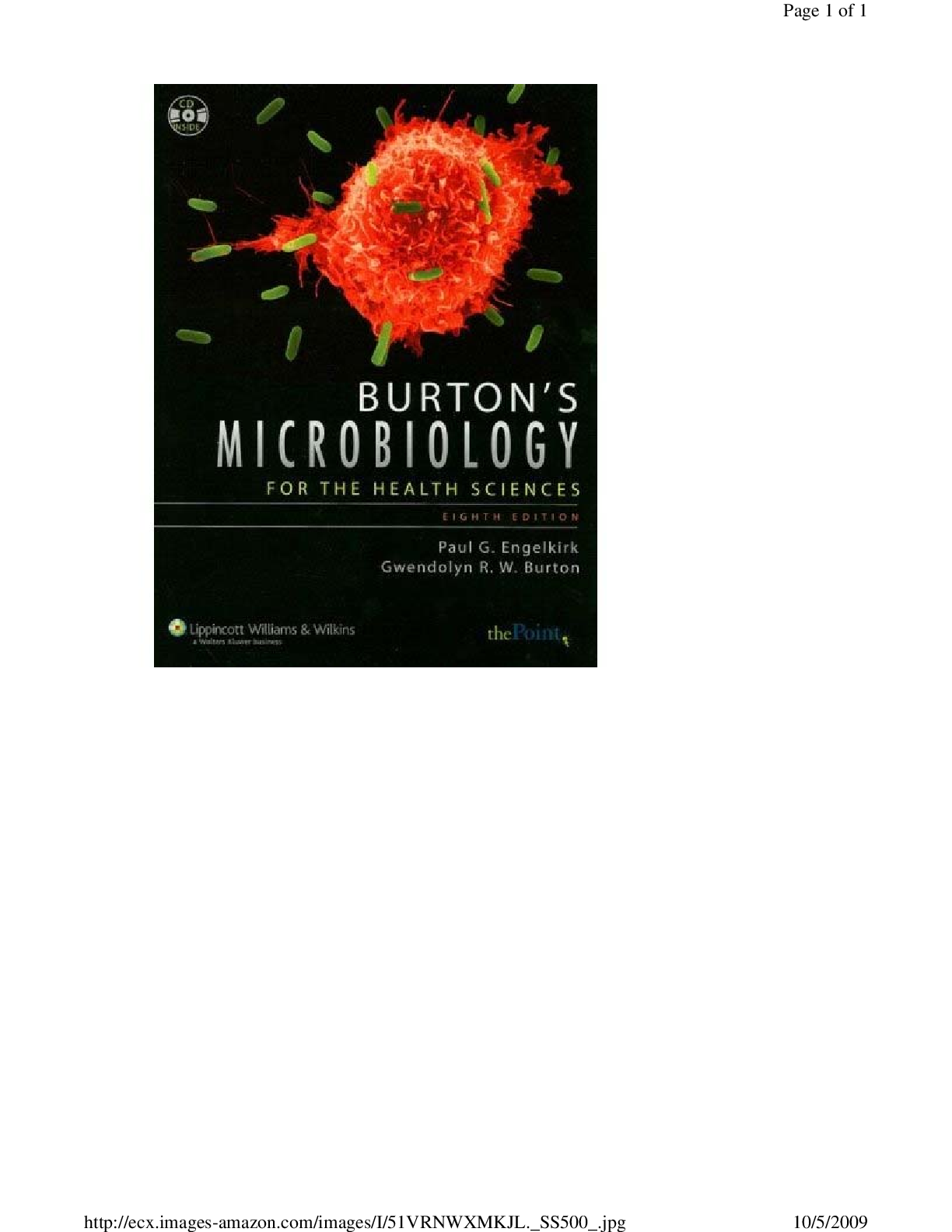
Buy this document to get the full access instantly
Instant Download Access after purchase
Add to cartInstant download
Reviews( 0 )
Document information
Connected school, study & course
About the document
Uploaded On
Apr 21, 2021
Number of pages
622
Written in
Additional information
This document has been written for:
Uploaded
Apr 21, 2021
Downloads
0
Views
98


